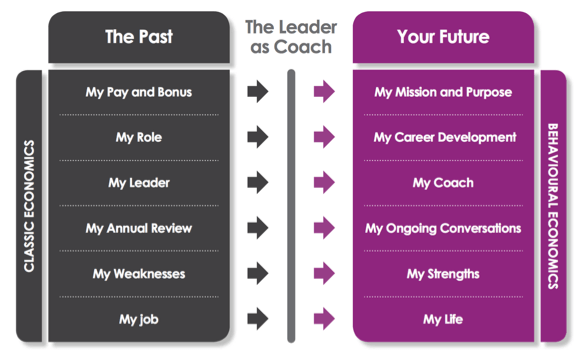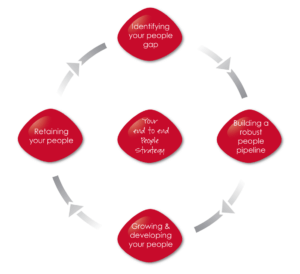 One of the highest costs associated with people attrition is the recruitment, induction, and training of a new employee following the departure of an existing one.
One of the highest costs associated with people attrition is the recruitment, induction, and training of a new employee following the departure of an existing one.
And this is just the hard cost.
It excludes the ‘opportunity cost’; the lack of continuity with customer relationships, the change in team dynamics, and the lead-time an individual requires to become fully operational, all of which impact the capability of your business to deliver your accelerated growth plans.
BE Offices estimates the total cost of hiring a new employee from salary to office space is £53, 241 after taking into account; job advertising (est. £3,000), average salary (est. £27,600), bonus (est. £1,656), NIC (est. £4,037), pension (est. £276), holidays (est. £2,972), training (est. £1,068), office space & equipment (est. £4,800), other costs (sickness, software licences, est. £8,000).
So, for your £27,600 paid new team member, you’ll need to budget for something closer to £53,000.
And this EXCLUDES your time sifting and vetting applicants during the recruitment process and the time it takes managing their induction into the business.

So whilst some of the hard costs listed above will remain, irrespective of whether it’s a new employee or an existing one, isn’t it just easier to keep hold of the good people you’ve got? Especially if they’re your top talent or high potential people?
Though some attrition is unavoidable, for your business to grow, it should be a priority to retain your best people.
When good people leave, it’s a certainty that the reason behind it is linked to one of the following; inspirational leadership, personal and professional growth, clarity of purpose, alignment with values, a deep connection with the WHY, a belief in the organisation, its reputation, its name and its social behaviours, and an expected level of reward and remuneration.
These are all triggers for employees to choose to stay or go.
So, how can you retain your best people?
In a world that has become impersonal, where the big things make little difference, it’s the little things which make a big difference.
#1 Non-monetary rewards
A well-known scene from the movie Jerry Maguire involves the following shortened telephone conversation between Jerry Maguire, a sports agent played by Tom Cruise, and Rod Tidwell, a National Football League wide receiver played by Cuba Gooding, Jr…
Jerry: What can I do for you, Rod? You just tell me. What can I do for you?
Rod: It’s a very personal, a very important thing. Are you ready, Jerry?
Jerry: I’m ready.
Rod: Here it is: Show me the money. Oh-ho-ho! Show! Me! The! Money! A-ha-ha! Doesn’t it make you feel good just to say that? Say it with me one time, Jerry!
Jerry: Show me the money!
Rod: Yeah! Louder!
Jerry: Show me the money!!
Rod: I need to feel you, Jerry!
Jerry: Show me the money!!! Show me the money!!!
Rod: Congratulations, Jerry, you are still my agent.
As played out in this scene, monetary rewards can be a very powerful determinant of motivation and performance but there are limitations to what monetary rewards can do in terms of enhancing individual and business performance.
Monetary rewards do not improve an employees’ job-relevant knowledge, skills, and abilities, their personal or professional growth, nor does it improve the quality of the role, the ‘job enrichment’ factors such as flexibility, autonomy, responsibility or empowerment.
Personal job satisfaction is driven by far more than financial factors such as salary and benefits.
Increasingly, non-monetary rewards are becoming key differentiators, highly valued by employees. These include relocation services, career development, choice of location, and an improved work-life balance through flexibility with hours and days of working allowing time to spend with children, attend school functions and sports days for example.
Organisations that consider people as merely a resource tend to have difficulty retaining good people.
They generally end up over populated with amber and red employees and under populated with green employees.

This is a traffic light system whereby green reflects your top performers based on both performance and potential, amber reflects the right person in the right place who might need developmental help, or the right person in the wrong place, who might have an excellent attitude, but whose skills could be better utilised in another role within the business and red reflects the wrong person for the organisation on both performance and potential.
Organisations that value people as their greatest assets and demonstrate it through their actions are positioned to retain their good people and top performers who are the strongest catalysts for business growth.
#2 Lead people as they want to be led, not how you like to be led!
The pathway to unlocking the potential in our people has changed.
Today individuals are wired, motivated and driven by very different needs and wants and understanding the fundamentals of what motivates and drives them is critical to attracting, developing, retaining and yes, inspiring people to do their best work.
There has been a change.
There is an old way of thinking versus a more fresh thinking approach
Leaders must acknowledge a shift in their thinking from classic economics (the old way of thinking) to behavioural economics (fresh thinking) and leverage these opportunities when building their compelling employee value proposition.

The hunt for talent is hotting up and individuals have more choices than ever about who they choose to work for.
#3 Your Employee Value Proposition (EVP)
In your People Strategy, your key differentiator is your Employee Value Proposition (EVP).
What is an EVP?
Basically it’s the balance of the rewards and benefits that are received by your employees in return for the skills, capabilities, experiences, and performance they bring to your organisation. The EVP is employee-centred and designed through a deep understanding of what is important to existing and potential employees.
It must be unique, relevant, and compelling if it is to act as a key driver of talent attraction, engagement, and retention. Your EVP is one of your most compelling and exciting tools to inspire and motivate your people.
Is it really that important?
Yes.
Gallup released numbers in 2015 indicating that only 13% of employees worldwide are truly engaged in their work. The other 87% vary from partially to fully disengaged. They come to work, go through the motions without any sense of enthusiasm that would encourage them to take ownership, and push to improve their own performance.
That’s terrifying!
A compelling people strategy is not just a ‘nice to have’ in your business growth strategy; it is a ‘must have’. The success of your organisation is hardwired to the productivity of your people, and since that calls for them to contribute their whole self, there is an absolute need for a strong, compelling EVP.
Building your EVP
You don’t have to have a dedicated HR function to develop an EVP.
Here’s my framework I use, which is split into four key areas; organisation, culture, career and reward. Hopefully this will help stimulate your thinking on all the facets to consider when building your EVP.

A well-formed EVP will result in increased attraction and retention of key talent, help create a strong people brand, help re-engage a disenchanted workforce, and reduce hire premiums.
If an organisation’s EVP matches their people’s personal values then a win/win/win scenario exists.
An employer can count on a motivated, committed worker who will go the extra mile.
The employee will experience a job which is meaningful and fulfilling.
And as a result, both will benefit from a mutually beneficial long-term relationship.
Your end-to-end people strategy
Over the past few weeks I’ve focused entirely on an end-to-end people strategy from identifying your people gap, hiring and recruiting talent, building a people pipeline, growing and developing your people and finally retaining them.

But there’s one final point I want to leave you with, which is this…
The Proud factor
Are your people proud to wear the company badge and are they brand advocates?
This should be the number one question on every single employee survey.
When your people are out on a Friday evening with friends, and the friends are all griping about work, do your people say ‘you know what, I’m sorry you’re in that position because I work for a great business and I am really proud of working for them’?
That’s the proud factor in action. Do you have it in your business?

